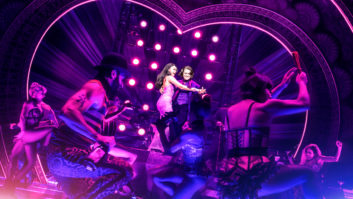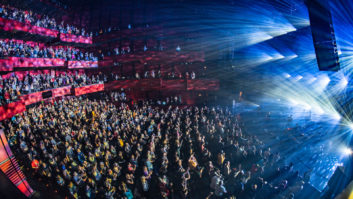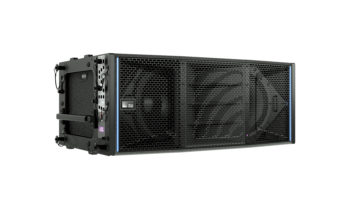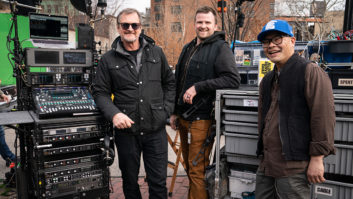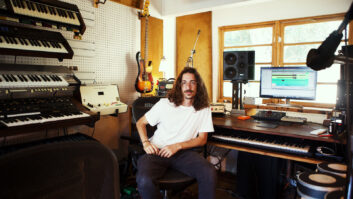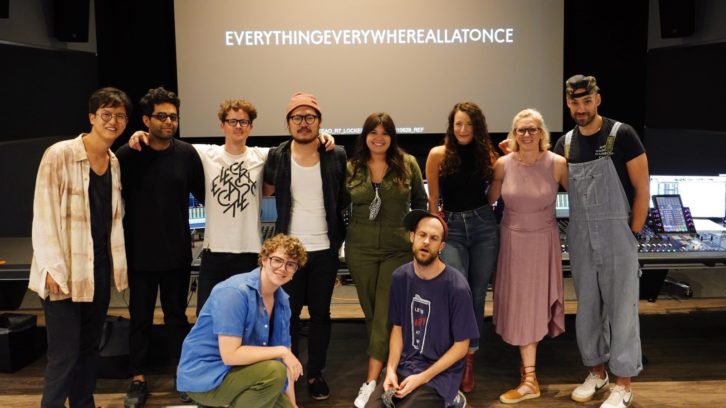
FROM THE JULY, 2022 ISSUE OF MIX
Award-winning directors Daniel Kwan and Daniel Scheinert—the Daniels— have already made their mark on filmmaking. Their feature-length directorial debut, Swiss Army Man (2016), starring Paul Dano and Daniel Radcliffe, is a life-affirming, unforgettable film of survival, resilience, perseverance and flatulence.”
Their follow-up, Everything Everywhere All At Once, is equally distinctive, traversing subjects ranging from the existence of parallel universes, to tax evasion, to universal consciousness, to generational trauma, to social acceptance, to dysfunctional relationships, to… It bears the Daniels’ distinct brand of outré humor (think kung fu fights with a fanny-pack, and a reality where hot dog-fingered humans play piano with their toes). Such out-there, creative concepts call for a filmmaking team that is willing to get weird. For sound, Emmy and MPSE Award-winning supervising sound editor/re-recording mixer Brent Kiser, owner of Unbridled Sound in Los Angeles, fit the bill perfectly.
“After Swiss Army Man, the Daniels started talking about this fun new film,” Kiser recalls. “Then in 2019, producer Jonathan Wong said they had a script and asked if I wanted to see it. I said, ‘Yes, but will I understand it?’ The hard thing about reading these scripts is that they’re so amazing and you’re laughing as you’re reading them, but you’re also thinking, ‘How is this going to work?’”
Having sound supervised and co-mixed Swiss Army Man (with re-recording mixer Beau Borders), Kiser knew that Everything would require some creative contortionism. He tapped MPSE Award-winning sound designer Andrew Twite, ADR supervisor Julie Diaz, re-recording mixer Alexandra Fehrman, John Sievert’s Foley crew at JRS Productions, and sound effects editors Reese Richardson,” Kailand “KC” Reilly, and Jacob “Young Thor” Flack, among a few others.”
TUNING AND STATIC
“Verse jumping,” for those scenes when a character connects with a different version of themself from another reality in the multiverse in order to obtain their skills, became the first sound design task. From a sound perspective, the team needed to find a way for the verses to intermingle, to make it feel like elements from one verse are being pulled into another. For this, Kiser and Twite (also a Swiss Army Man alum) developed a radio-tuning transition.
“It became a great narrative tool that added to the story, but also assisted us in connecting these weird spaces and moments,” says Twite.” “They just tossed us this first scene and said, ‘We need to feel different verses coming through, and that everything’s breaking down. Go!’”
The first taste of verse jumping was an epic hallway fight in which antagonist Jobu Topaki confronts Evelyn. Jobu has mastered verse jumping to the point that she’s simultaneously experiencing every version of herself all at once. Twite typically starts his sound design by recording, with his most recent rig including an Audio-Technica BP4025 stereo mic feeding an Avid Omni preamp directly into Pro Tools. For the radio-tuning elements, he recorded frequency sweeps, tuning and “roger” beeps from an old two-way radio, and a small, handcranked AM/FM camping radio, where “I was often tuning through channels, trying to find those places that ride the line between reception and static,” he says.

These recordings were loaded into Soundminer, which features a built-in DSPRack that supports both VST2.4 and AU plug-ins, allowing Twite to try out numerous plug-ins and processing chains to discover possible textures and movements before rendering into Pro Tools. “I used Kilohearts Snap Heap quite a bit with the radio elements,” he explains. “Snap Heap is a modular-based plug-in; you can add a wide variety of modules or Snap-ins to create or modify sounds. You can run the modules in parallel or in series, and each module can be controlled independently while you are tweaking your sound. I feel like I have only scratched the surface of what is possible.”
Twite’s favorite radio-tuning moment plays during a fight in which a security guard gets pummeled by two oversized dildos. “We hit a slow-motion moment, and one ‘weapon’ bends toward the camera,” he says. “I ran a radio frequency sweep and roger beep through Snap Heap with a Frequency Shifter, Ring Mod, Dynamics module for boosting specific frequencies, and a Delay, and I got this crazy bending sound with the beep accent right as the ‘weapon’ is bent all the way forward. It’s a great accent for the moment. I just love it.”
One hallway scene also has huge waves of multiverse energy, which the Jobu character conjures during her confrontation with Evelyn. For that sound, Twite recorded a two-foot section of eight-inch ribbed tubing by inserting an A-T AT897 short shotgun mic into the tube and then scraping the tube’s exterior with a wooden dowel at different speeds, and with the tube bent in different directions. He manipulated the recordings using a pitch shifter before running the sounds through Ina-GRM Tools Doppler plug-in to create long, textured whoosh-bys. Twite also created breathy vocal whooshes using the Sennheiser MKH 8050 mic. Those recordings were pitched down significantly to create airy whoosh elements that play in tandem with the tube whooshes.
“Once we got to the mix stage and fine-tuned the panning, you can feel them pass around you, especially in the Dolby Atmos mix. They turned out to be really effective, albeit quite simple,” he says.
RECORDING A MULTIVERSE
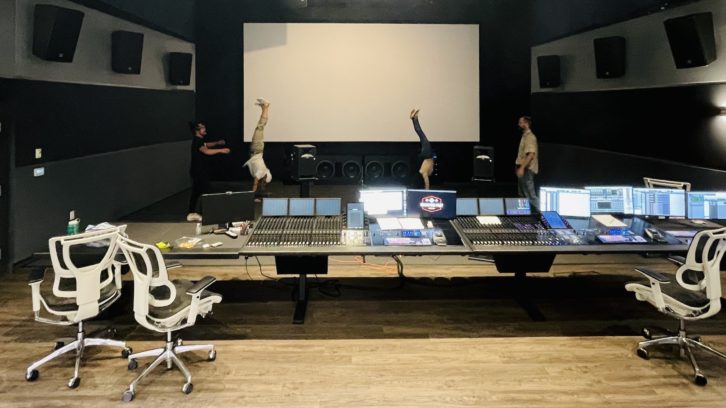
‘Everything Everywhere All At Once‘ features unusual, creative concepts, so its sound team had to get equally out-there. Don’t miss Part 1!
The Daniels’ ideas of what might exist in parallel universes range from nearly normal to flat-out bizarre. In one verse, humans have hot dog hands. Twite created the hand sounds by recording a collection of very thin belts pilfered from his wife’s closet, twisting the leafy ends of leeks, drumming his fingers on his belly, and adding in a dose of cat food squishes that the Daniels favored.
In another verse, a raccoon named Raccacoonie (voiced by composer Randy Newman) hides under the hat of a novice Hibachi chef, controlling his movements by tugging on the chef’s hair. ADR supervisor Diaz used Sounds in Sync’s EdiCue to help cue Newman’s lines and his singing, but he also performed lots of extra material off-the-cuff, channeling the inspiration of being a raccoon that’s been picked up by animal control.
“Randy was amazing. He was just riffing off all these lines and we were all laughing,” says Diaz, who passed much of the additional takes and improvisations over to composer Ryan Lott of Son Lux, who did the score. “A lot of the extra takes were added to the songs in the soundtrack, as were recordings from actress Stephanie Hsu, who played Joy/Jobu. She was randomly singing in the ADR session, and that ended up in the soundtrack for the movie.”
Diaz also recorded the Martial Club—a Hong Kong-style martial arts trio of brothers Andy and Brian Le and their friend Daniel Mah—who helped to coordinate the fight scenes and also appeared on screen for a tussle involving a fanny pack. “We had them in the recording room, and they’re literally fighting each other so we could get realistic grunts and efforts,” Diaz explains. “There is a five-minute recording of them doing flips and trying not to kick the mic. Then, at the end, one would say a line from the film that goes, ‘Oh, Kevin. F**k.’ and get hit in the face.”

The ADR fight sound sessions were important for building out the numerous fight scenes in a visceral and brutal way. Kiser notes, “Their efforts and grunts added a whole other level of detail. The whooshes and impacts accentuate the precision of the movements, but ADR efforts and grunts are what ground the fights in reality.”
While the majority of the film is full-on sound, there are moments of reprieve, such as the verse that consists of nothing more than majestic rock formations and shifting winds. Re-recording mixer Fehrman worked with director Scheinert to craft Twite’s trove of wind tracks into a delicate scene that capitalizes on the Dolby Atmos capabilities.
Fehrman says: “It started as this big atmospheric moment, but we slowly boiled it down. Dan [Scheinert] was very specific. He wanted us to be able to trace one wind that comes in from the left and then another one that sort of drifts in after that. There’s a distant wind chime. It’s a moment to breathe and meditate on all that we’ve just seen and heard in the film. Everything is very subtle, yet immersive.”
THE EVERYTHING BAGEL
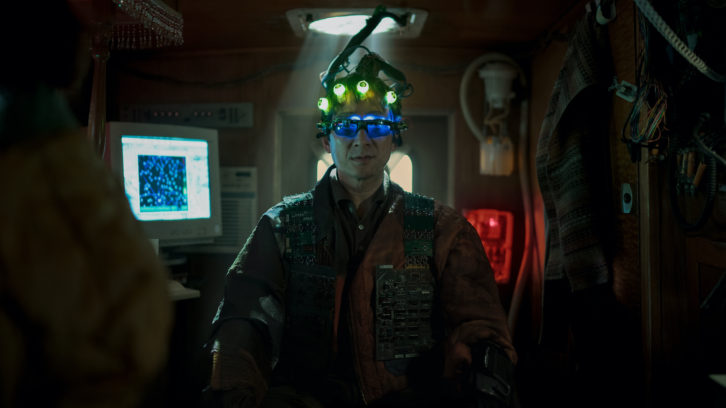
‘Everything Everywhere All At Once‘ features unusual, creative concepts, so its sound team had to get equally out-there. Don’t miss Parts 1 and 2!
Our antagonist Jobu’s omnipotence has led her to a nihilistic outlook on life. She’s taken everything she’s ever felt, thought and experienced from all iterations of life across the multiverse and put it onto a bagel. This “everything bagel” is like a black hole, which begs the question: What does a black-hole, everything bagel sound like?
Twite started by recording a bagel, naturally, using a Sound Devices 744t and a Sennheiser MKH 8050. He captured sounds of crushing, crumbling and tearing a toasted bagel and a piece of toast, along with the sounds of a butter knife scraping their surfaces. “I also intentionally burnt about six pieces of bread and stacked them on top of one another and just slowly crushed all of them at once by putting pressure on the stack with my hands,” Twite says. “Those cracks, once pitched and tweaked, became one of the main textural layers of the everything bagel. The MKH 8050 has a really tight polar pattern, and its ultrasonic recording capabilities allow the samples to retain strong high-frequency content, which made for some great sounds once I started doing pitching and time manipulation.”
During one of the spotting sessions, director Kwan described the everything bagel as being like a washing machine or dryer with a very slow-spinning, constantly moving, elemental force. To achieve this rhythmic quality, Twite tried several ideas but discovered the best source for sound was his rowing machine, where he was able to control the speed of the machine itself to get a wide range of rhythmic beds.
“I recorded it straight into my Omni [preamp] using an Audio-Technica BP4025 stereo mic,” he explains. “It worked out really well because the sound of the machine itself is rhythmic by nature and sits at a mid/mid-low frequency range. It also has this almost whine-y moan to it that I love because it adds to the despair I associated with the everything bagel. I could stretch out the slower rows to play really, really slow when the bagel is just chilling behind the curtain. Or, I could really speed up the rowing, and that texture was helpful for when the bagel is spinning out of control and pulling everything into itself.”
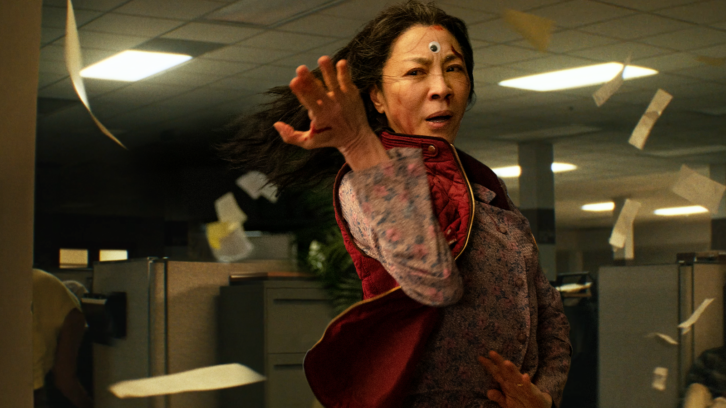
Re-recording mixer Fehrman (effects/ backgrounds/Foley) joined Kiser for the native Dolby Atmos mix at Signature Post on Mix Stage 1 in Burbank, Calif. They mixed on a dual-operator Avid S6 M40 24-9-D control surface, with monitoring via JBL 5732 mains, JBL 9320 surrounds, and JBL 5628 subs with JBL 7118 surrounds for low-frequency extension.
This was Fehrman’s first time working with Unbridled Sound, and coming in at the end meant opening an unfamiliar Pro Tools template that was 300 tracks wide, figuring out the layout, grouping and busing tracks, and listening through layers of complex designs.
“I opened the sessions ahead of the mix to familiarize myself with where everything was, and I decided that I’d just have to hit the ground running,” she says with a slight laugh. “There was literally everything in the session, from natural backgrounds to sci-fi elements, and so many fight scenes.””
One of the most challenging scenes in terms of the mix was when Jobu and Evelyn confront each other in the woods. Jobu snaps off a tree branch and it transforms into several different objects before becoming a sword. There is big score and important dialog. “There’s all this chaos of everything changing, and we had to poke out little tiny moments so that you could understand what Jobu was saying,” Fehrman explains. “In that little section, there were such fast and small events; it required lots of quick fader moves. We did try to put some of the sounds in Atmos, but it’s hard to register because it’s happening so quickly.””
The Atmos surround field worked best for spatially specific effects, like the overhead lights flickering in the hallway scene, and for the verse-jumping radio transitions. “In Atmos, we were using that transition in conjunction with voices that were pulling us into different verses. It was very effective,” says Fehrman.”
Everything Everywhere All At Once isn’t about the everything bagel. Nor is it about the future-tech ability to jump into different universes. It’s less about conflict and more about resolution through acceptance and appreciation.
“This is an important film that shines a light on the challenges we face as humanity, and all the important themes in the film were mirrored in the way that the film was made,” Kiser concludes. “The directors are so crew-focused; we never felt like the hired help. And I’m so blessed that I have great people that I can help empower to do their amazing jobs. That’s what a supervisor should do. I’m thankful that I’ve been surrounded by great people on this film—clients and team.”

